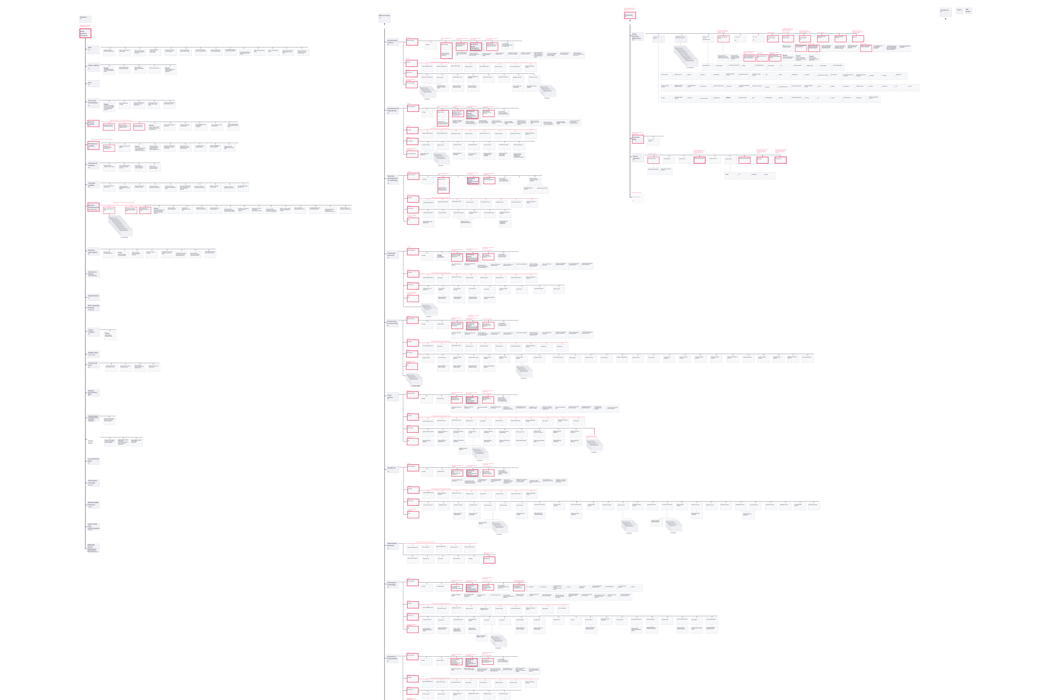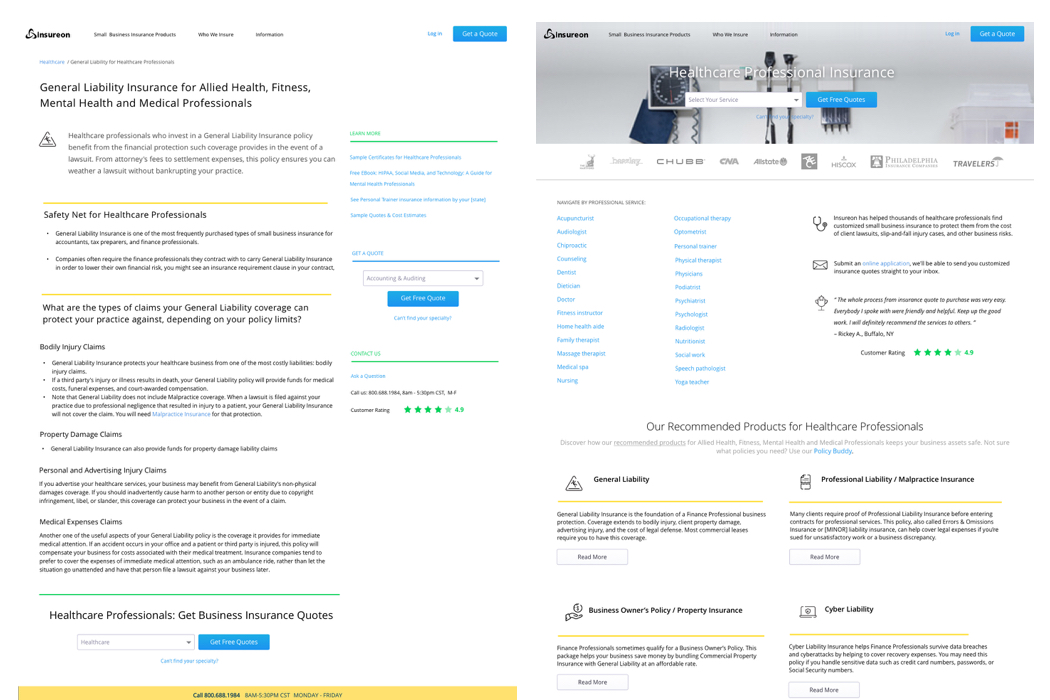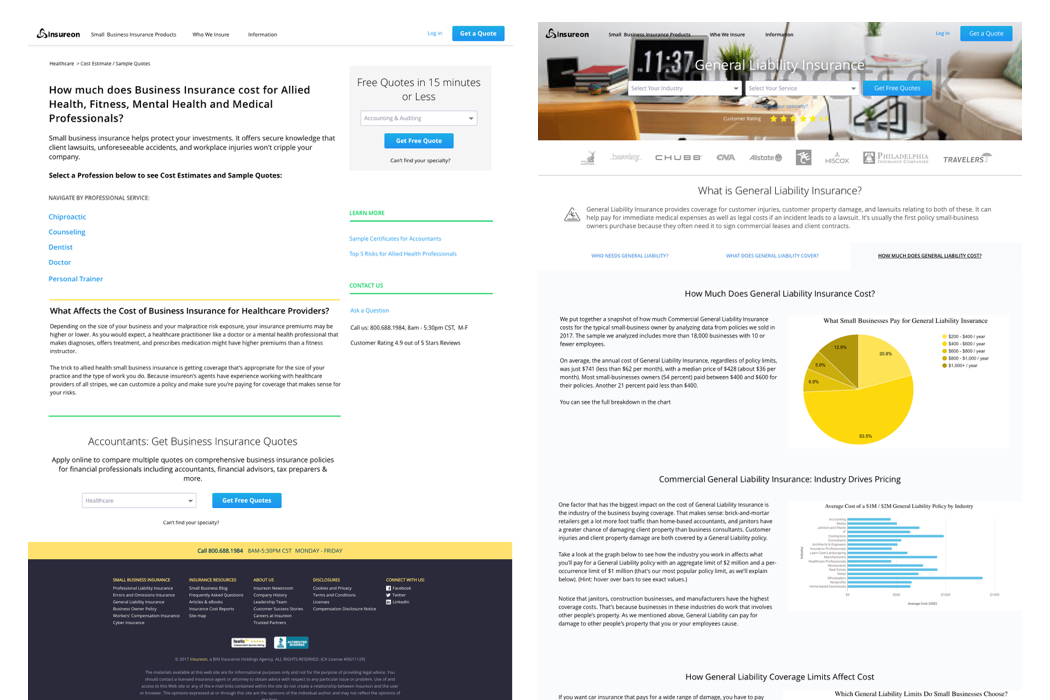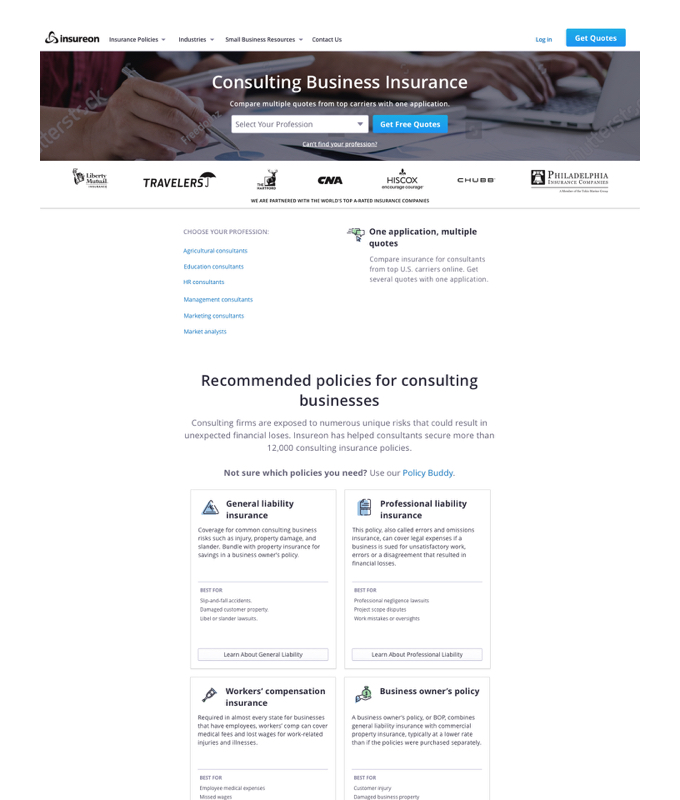Insureon template redesign
Developing a template system to be used across the Insureon ecosystem.The Problem
One of my first tasks at Insureon was to assess the Insureon.com ecosystem. I found that it was bloated, as partial redesigns had been initiated throughout the Insureon ecosystem. Content was outdated and vital user information was sprinkled across many pages. There was no clear categorization of pages, or a clear linking pattern. The user journey was a “wild wild west”, lacking a clear navigational structure for our users. The previous partial redesign efforts resulted in many different legacy template designs, and inconsistent code structure on the back end. In the past, various page types were created as one-offs, allowing for a huge number of pages that could not be updated systematically.


There were numerous legacy template types in the Insureon ecosystem prior to the redesign. Above is just a select few.
Every page attempted to act as a landing page, resulting in really long pages for the user to read, often with the same information repeated across pages. The result was a website architecture that was all one level, forcing users to really have to dig into long pages of content to find their answer. In addition, a large majority of the pages were not responsive, which really hindered Insureon in SEO.
Identified areas for improvement:
- Implement a templatized strategy to the website that leverages a consistent type style
- Prune the content on outdated pages
- Build leveraged components that can be updated individually across the ecosystem, allowing future updates to happen systematically
- Build the ecosystem around a user centered global nav, establishing a clear hierarchy and purpose for each page
- Identify customer intent when they land on Insureon.com and map that to pages in the architecture


Some of the extensive information architecture mappings during my assesment of the Insureon.com ecosystem.
Constraints
Amount of existing content
One of the redesign requirements was to provide a clear hierarchy of information. This would allow users to travel farther down the Insureon content tunnel as needed. A main aspect of the business is to focus on individual small business professions and provide them with industry specific content. In some cases, we had around 40 pages of unique content to support just one profession (Insureon supports over 500 professions).
Tags
In the current ecosystem, there was no opportunity to add search to the page due to lack of tagging or categorized metadata present at the page level. When I met with the content lead on the project, there was hesitation to add tagging as their previous experience with tags was an added “bloat”. I explained the long term goal of search, and that search required a user facing tagging system, as well as robust metadata logic. SEO and design met with content to create a tagging system that would account for the entire ecosytem.
Culture change
One of the only metrics that the entire ecosystem was being measured on was the click-to-application (user initiates an Insureon insurance application) and the application completion ratio (user completes the entire Insureon insurance application). As Insureon continues to grow, they wanted to get more qualified candidates through their funnel. To achieve this, we had to present content higher up in the funnel. We reduced the prominence of the call to action above the fold. The existing pages had a high click-to-app rate, but low conversion of app completion. This was mainly due to the user seeing only the call to action above the fold, with any validation content below that users rarely read. The new template design reduced the call to action prominence significantly, which challenged the past business mentality that a prominent call to action was necessary to meet those metrics.
Design Strategy
Working with the SEO team, we knew that there were only about 4 aspects of the profession specific to small business insurance.
- Why that profession/industry needs business insurance
- Cost of business insurance for that profession/industry
- Recommended policies for that profession/industry
- State specific information that pertains to that profession/industry
These aspects needed to be addressed on one page, with a link out to further reading if the user required it. Consolidating to address all 4 aspects on one page eliminated hundreds of pages. Each document would have custom content for each industry/profession, but the visual layout would remain consistent. This concept meant that we could create each aspect in a flexible module that leveraged reusable components for each template.
The four aspects identified translated to:
- Cost module. Flexible H2 with an image and supporting body text and a button link. Supports content for the cost of business insurance for that profession/industry.
- Policy cards. H3, icon and supporting body text, button link. Supports content for recommended policies for that profession/industry.
- State module. Flexible H2 with an image and supporting body text, dropdown selector, button link. Supports content for the state specific information that pertains to that profession/industry.
Team and Stakeholders
Content Team
Aligned with SEO and Design to apply the tested content strategy to scale for authors.
Product team
Product Management was a key member of this redesign project team. I worked alongside a Design Manager who provided support with leadership and design feedback.
SEO
Led the content strategy with Design for the template design and testing strategy.
Design Process
- Assessed each template and page type in the Insureon ecosystem with SEO. SEO generated a proposal for pages to be retired, and templates to be manually migrated to new template via hand authoring.
- Defined purpose of each new template based on user intent.
- Outlined list of components in use across all templates.
- Mapped types of existing pages to new templates designed.
- Designed and tested templates to determine improvements and metrics for each page type.
- Handed off components and modules with purpose, usage, detailed specifications to Engineering for technical implementation in the new CMS.
- Specified authoring workflows for each template and proposed designated components and modules to leverage for each.
- Worked with SEO to determine product and content associations that could be addressed through tagging properties in an effort to eliminate some hand authoring and create consistency across documents in the ecosystem.
Explorations of template designs



Some of the template design explorations.
Universal elements
The following elements are present throughout the redesign strategy. Global navigation
Insureon’s previous global navigation was a reflection of their internal business structure. By eliminating old content, we created clear labels for the user that align to their mental model when shopping for business insurance. We also aligned Insureon’s site categories and site taxonomy to match up with users’ mental maps. The new global navigation was mapped to users’ search queries when seeking business insurance and tied to groups by insurance policy type, industry, and small business resources. An open card sorting test and usability testing was conducted to validate the updated structure with users. This project was a key aspect in setting a new foundation for Insureon.com. The global navigation improvements helped drive alignment across the team on Insureon’s business objectives, which in turn helped to set clear categories and page types (templates) on the website.
Call to action at bottom of the page
The call to action module catches users at the bottom of the page. This module was created to align to Insureon’s key business obective: direct qualified users to start the Insureon insurance application. User insights led us to develop a dynamic module. Depending on the page, the module can be preset with applicable industry and profession by an author.
Visual Design




After the rationalization, four main templates (Policy template, Industry template, Profession template and Article template) were developed to handle the majority of the content in the Insureon ecosystem.
Templates created for the Insureon ecosystem
Policy template
A tabbed template built to make browsing content easier and more accessible for the user. This page type contains comprehensive content about a specific insurance policy. Before the redesign, there were some cases with more than 10 pages of content about one policy, with vital information sprinkled through the page. See the General Liability Policy page.
Industry template
A landing page for larger industries (example: Healthcare, Real Estate) that serves mainly as a router page to enable users to navigate to a more specific profession where they can access profession specific recommendations. Industry recommendations and cost data are also provided on this page type. See the Food & beverage industry landing page.
Profession template
A landing page for a specific profession (example: Doctor, Landscape architect, Bar owner). Our users are more likely to land on this page first in our ecosytem, as organic search tends to align to the specific profession the user inputs. It serves as a page where we can make profession specific insurance policy recommendations, state specific information for that profession, and profession specific cost data. See the Restaurant profession landing page.
Article template
A template that serves for topic specific content that exists farther down the funnel (example: “Workers compensation for general contractors” or “How much insurance costs for dentists”). This page type allows for more content to be displayed on the page, as well as a right rail for related links, navigation by topic tags, and contact information. The breadcrumb present on the article template orients the user in the ecosystem. See the “General Liability for independant contractors” page.
Testing
With the reduced size of the call to action above the fold, we were concerned about the click-to-app rate and qualified candidates that completed an application. We decided to run usability testing on a prototype to test modules and value propositions on the page. Following that, we built the page statically, so we could A/B test against the “old” template.
When reviewing the test results, we saw that users were actually reading and consuming more content than they had in the previous template. Users were also able to understand Insureon's main value propositions upon landing on the page. This was something that was not achieved previously in previous template designs.
Conclusion
One the best improvements for our user was the global navigation changes that increased findability on the site. Matching users’ search intent led to a positive user experience on the site. In addition, the new breadcrumb in the article would consistently make it clear to the user where they were on Insureon’s website at all times. Exposing the content team to the global navigation project helped to drive prioritization of pages for authors. Each page on the site now has a clear purpose, intent, and categorization which will help to eliminate some of the content “bloat” that we had experienced previously.
With the four main templates tested and validated, the next step is having engineering migrate these designs to the newly selected CMS. Once large amounts of content are in a new ecosystem, we can move users through our funnel more effectively. Using the capabilites of a robust CMS and applied analytics, monitoring trends and identifying improvements will continue.